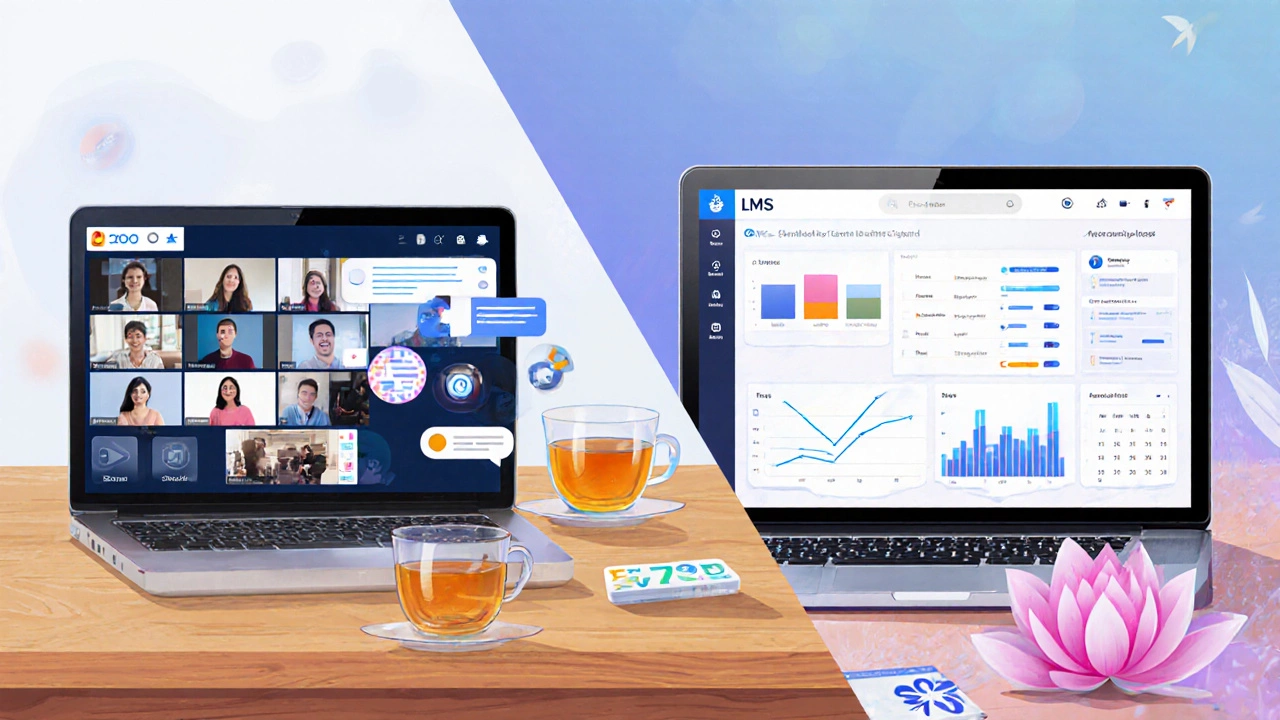Sep
27

- by Dhruv Ainsley
- 0 Comments
Zoom vs. LMS Suitability Checker
This tool helps determine if Zoom alone can meet your eLearning requirements or if you need a dedicated Learning Management System (LMS).
Assessment Criteria
Asynchronous Needs
Assessment & Grading Requirements
Zoom is a cloud‑based video‑conferencing service launched in 2011 that enables real‑time video, audio, and screen sharing for meetings, webinars, and virtual events. It supports up to 1,000 participants in a single call, offers cloud recording, breakout rooms, and a range of integration APIs. While Zoom’s popularity skyrocketed during the pandemic, the question remains: does it count as an eLearning solution or merely a communication tool? This article breaks down the core traits of eLearning, evaluates Zoom’s capabilities, compares it with traditional Learning Management Systems, and gives practical guidance for educators and trainers.
Throughout the piece you’ll see how Zoom stacks up against dedicated platforms such as Moodle, a free, open‑source LMS that powers thousands of universities worldwide. Keep reading to decide whether Zoom can replace, complement, or simply supplement your eLearning strategy.
What Makes a Tool an eLearning Platform?
eLearning is a digital learning approach that delivers instructional content, assessments, and interaction through the internet. Core attributes include:
- Structured course management (modules, lessons, prerequisites)
- Assessment and grading capabilities
- Progress tracking and reporting
- Support for both synchronous (live) and asynchronous (self‑paced) activities
- Integration with external tools like content libraries, authentication services, and analytics
Platforms that bundle these features under a single umbrella-think Canvas, Blackboard and Moodle-are typically classified as Learning Management Systems (LMS). However, the line blurs when communication‑focused tools add rich classroom features.
Zoom’s Education‑Focused Feature Set
Zoom has expanded far beyond simple calls. Its education‑oriented add‑ons include:
- Breakout Rooms: split participants into smaller groups for discussions, labs, or peer review.
- Polling: launch multiple‑choice questions in real time, collect responses, and display results instantly.
- Cloud Recording with transcript generation, enabling review of lectures and compliance with accessibility standards.
- Whiteboard: a shared canvas for sketching diagrams during live sessions.
- Integration with LMSs via Zoom Plugin for Moodle and similar connectors that push attendance data back into gradebooks.
These capabilities address the synchronous side of eLearning-live lectures, real‑time Q&A, and collaborative activities. What they lack are built‑in asynchronous elements such as self‑paced modules, automated grading, and curriculum pathways.
Zoom vs. Dedicated LMSs: A Quick Comparison
| Attribute | Zoom | Moodle | Canvas | Blackboard |
|---|---|---|---|---|
| Primary Use | Live video meetings & webinars | Full‑featured LMS | Full‑featured LMS | Full‑featured LMS |
| Synchronous Support | ✔︎ (up to 1,000 participants) | ✔︎ (via plugins) | ✔︎ (via built‑in) | ✔︎ (via built‑in) |
| Asynchronous Content | ✘ (no native course modules) | ✔︎ (self‑paced lessons) | ✔︎ (self‑paced lessons) | ✔︎ (self‑paced lessons) |
| Grading & Assessment | ✘ (manual only) | ✔︎ (auto/ manual) | ✔︎ (auto/ manual) | ✔︎ (auto/ manual) |
| Integration APIs | ✔︎ (REST, Webhooks) | ✔︎ (LTI, SCORM) | ✔︎ (LTI, REST) | ✔︎ (LTI, REST) |
| Pricing Model | Subscription per host | Free (open‑source) / paid hosting | Subscription per institution | Subscription per institution |
| Max Participants | 1,000 (large‑event add‑on 10,000) | Unlimited (server dependent) | Unlimited (server dependent) | Unlimited (server dependent) |
The table shows that Zoom shines in live interaction but falls short on structured course delivery and assessment automation. If your program relies heavily on recorded lectures and discussion, Zoom can be the centerpiece. If you need a full curriculum pipeline, you’ll still need an LMS.

Real‑World Classroom Scenarios
Zoom is already the go‑to tool for many educational institutions. Here are three common setups:
- K‑12 remote learning: Schools schedule daily homeroom meetings on Zoom, use breakout rooms for group work, and rely on a separate LMS (like Google Classroom) for homework and grading.
- University lecture series: Professors stream large‑scale lectures via Zoom Webinar, record them automatically, then upload the videos to the campus LMS for on‑demand viewing.
- Corporate training: Companies run live skill‑building workshops on Zoom, embed polls to gauge comprehension, and later push attendance data into their HR learning portals.
Notice the pattern: Zoom handles the synchronous, interactive layer, while a dedicated LMS manages the asynchronous, administrative side.
Limitations When Treating Zoom as an eLearning Platform
Educators often run into these roadblocks:
- LMS Integration is optional, not native. Without plugins, you cannot automatically enroll students or sync grades.
- Content organization is flat-no hierarchical modules, prerequisites, or drip‑release schedules.
- Assessment tools are limited to polls or manual quizzes; there’s no built‑in quiz bank, randomization, or automatic marking.
- Compliance tracking (e.g., SCORM, xAPI) is absent, which matters for regulated industries.
Because of these gaps, most institutions pair Zoom with an LMS rather than replace it.
Is Zoom an eLearning Platform? The Verdict
Zoom provides the core ingredients for live, interactive learning: high‑quality video, breakout capabilities, real‑time polling, and recording. However, it does not deliver the full suite of course management, assessment, and compliance features that define a traditional eLearning platform. In practical terms, Zoom is best viewed as a Virtual Classroom tool that can be embedded within a broader LMS ecosystem.
If your training model is primarily synchronous and you have an existing LMS for content storage and grading, Zoom is a perfect complement. If you need an all‑in‑one solution for self‑paced courses, you’ll still need a dedicated LMS.
Related Concepts to Explore
Understanding Zoom’s role in eLearning opens the door to several adjacent topics:
- Webinar vs. standard meeting - when to scale to 10,000 viewers.
- Synchronous Learning best practices - engagement hacks for live sessions.
- Asynchronous Learning strategies - how to supplement Zoom recordings with self‑paced modules.
- API‑driven custom integrations - pulling Zoom attendance into your LMS’s analytics dashboard.
Each of these topics deepens your ability to design blended learning experiences that leverage Zoom’s strengths while covering its blind spots.

Frequently Asked Questions
Can Zoom replace an LMS for a small training program?
For short, instructor‑led sessions without complex grading or compliance needs, Zoom can act as a stand‑alone solution. You’d still need a simple file‑sharing method (e.g., Google Drive) for supplemental materials, but the core learning can happen entirely via Zoom meetings and recordings.
Does Zoom support SCORM or xAPI for tracking learner activity?
Zoom does not natively handle SCORM or xAPI. To capture those data points you’ll need to pair Zoom with an LMS that supports these standards and use the Zoom API to push attendance and participation data into the LMS.
What is the price difference between Zoom’s Education plan and a typical LMS?
Zoom’s Education plan starts around $149 per host per year, offering unlimited meetings and basic webinar capacity. A full‑featured LMS like Canvas or Blackboard often charges per student or per institution, ranging from $5 to $15 per seat per month, plus possible hosting fees. Overall, Zoom is cheaper for live‑only delivery, but the total cost can rise when you add a separate LMS.
How secure is Zoom for handling student data?
Zoom complies with GDPR, FERPA, and ISO/IEC 27001. End‑to‑end encryption is optional for meetings, and the Education plan adds data‑location controls for Australian institutions, making it suitable for most K‑12 and higher‑education environments.
Can I integrate Zoom with Moodle to sync attendance?
Yes. Moodle offers an official Zoom plugin that creates Zoom meetings directly from a course, records attendance, and writes it into the Moodle gradebook. It streamlines the workflow for instructors who already use Moodle for course delivery.





